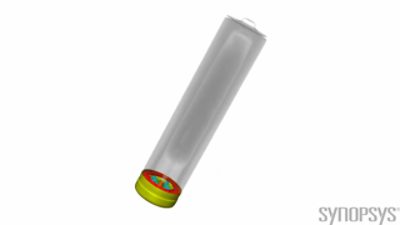Cloud native EDA tools & pre-optimized hardware platforms
Solving Battery Design Challenges with Simpleware Software
Posted on November 7, 2019 by Jessica James
Lithium-ion and other types of batteries are crucial to many applications, with manufacturers needing to innovate with lighter, longer-lasting, safer energy technologies meeting consumer demands. Improvements to batteries helps the technology of the future, from smartphones to electric cars, with 草榴社区 Simpleware software helping researchers tackle these challenges through 3D image-based modelling and inspection from industrial CT (computed tomography) and other types of data.

Micro-CT scan of an AAA battery (courtesy of Micro Photonics Inc.)
Optimizing Battery Performance with 3D Imaging and Simulation
Batteries can be scanned using 3D imaging techniques such as micro-CT and FIB-SEM to obtain their unique structure. From this data, properties such as ion distribution, interaction between different materials, and porosity, can be analyzed at the micro and nano-level to study performance and identify defects, leading to improved design decisions.
Simpleware software provides a software environment for visualizing, processing, analyzing and exporting battery image data as simulation-ready finite element meshes and 3D-printing files. The software provides a number of key benefits for users:
- The ability to model complex material geometry in detail and explore impact on properties
- A route to computational simulation testing complements and potentially reduces reliance on costly experimental testing
- An easy-to-use interface and simulation-ready, watertight meshing
- Customization and scripting options, depending on the workflow
With Simpleware software, just some of the common applications for battery modelling include:
- Visualization of the inner structure of batteries
- Statistical analysis of images, for example porosity
- Creation of high-quality FE/CFD meshes ready for simulation
- Deviation analysis between as-designed and as-manufactured models to identify defects
- Calculation of effective material properties (stiffness, permeability...)
Use-case: AAA Batteries

Segmentation of AAA battery data in Simpleware software
To understand how Simpleware software helps process 3D image data of batteries, it is useful to look at the information that can be extracted from a standard off-the-shelf AAA battery. A recent project involved providing micro-CT data of AAA batteries for processing in Simpleware software. Different insights were gained by using different techniques, for example:
- Importing and visualizing the unprocessed data in 2D and 3D by mapping greyscale information to color and opacity for 3D rendering, using focus contrast to highlight features of interest.
- Carrying out automated and manual segmentation to identify features, including threshold, flood fill, region growing, and Otsu operations, improving segmentation quality with morphological, smoothing, and local correction filters.
- Using the Simpleware local correction filter to work with large data-sets, such as those for batteries, to allow rough segmentation on greatly downsampled scans, before transferring to a full resolution scan to apply the filter. This allows fast initial processing, whilst reducing the impact of beam hardening artefacts by taking account of greyscale variation.
- Obtaining measurements, including point/distance/angles, volume statistics, and centerline analysis, as well as options to use an object-oriented bounding box, wall thickness analysis, and automatic fitting of primitive shapes for advanced measurements.

Some measurement and statistics of AAA battery data in Simpleware software
One of the more significant features in Simpleware software when working with batteries is dataset registration and surface comparison for quality control. This is where any type of data can be aligned and compared using landmarked and automatic methods, for example image to image, CAD to image, and CAD to CAD.

Dataset registration in Simpleware software: battery collector segmented from scan compared to CAD model of ideal collector (left); analysis of deviation of the registered surfaces (right)
This technique allows for visualization of surface deviations, as well as statistical information and raw data, to consider how a CAD design of a battery may differ from its manufactured or Additive Manufactured version, and how this affects performance.
You can see how all these steps come together in the video below:
Visualization and Segmentation of AAA Battery in Simpleware Software
User Success Stories
Just some of the examples of how Simpleware software is used for battery modelling include recent work at the Universities of Waterloo, Akron, Carnegie Mellon, and Indiana University-Purdue has included analysis of the heterogeneous microstructure of lithium-ion batteries. This application involved studying the LiFePo4 electrode microstructure of a lithium-ion battery is reconstructed from nano-CT, and exporting to COMSOL Multiphysics? for simulating cathode performance at different discharge rates. From this work, researchers can better understand how spatial distribution of lithium-ion within the actual microstructure of the battery electrodes affects performance.
3D reconstruction of lithium ion battery from nano-CT data in Simpleware ScanIP (Universities of Waterloo, Akron, Carnegie Mellon, and Indiana University-Purdue)
Other projects using Simpleware Software include work at Imperial College and University College London on improving the lifetime and degradation of solid oxide fuel cells. This method involved studying batteries at the nano and micro-level in relation to thermal, electrochemical, and stress factors. Simpleware software provided a solution for processing image data and exporting meshes for simulation, allowing researchers to study the lifetime and degradation of fuel cells at different scales, characterizing principal stresses across phases and interfaces.
Dr. Farid Tariq, who was part of this project, has described how Simpleware Software “forms part of the workflow that provides insights into effects which may be difficult to experimentally measure, which may be sources of performance degradation, and areas to target for microstructural optimization”.

3D Reconstruction of a Solid Oxide Fuel Cell - pores green and ceramic transparent (Imperial College and University College London)
Given the potential for capturing very specific details of battery technology using imaging, as well as increases in computing power to allow more realistic simulations, these workflows are only going to grow in importance for the battery industry.
Any Questions?
Do you have any questions about Simpleware software or need additional information?






